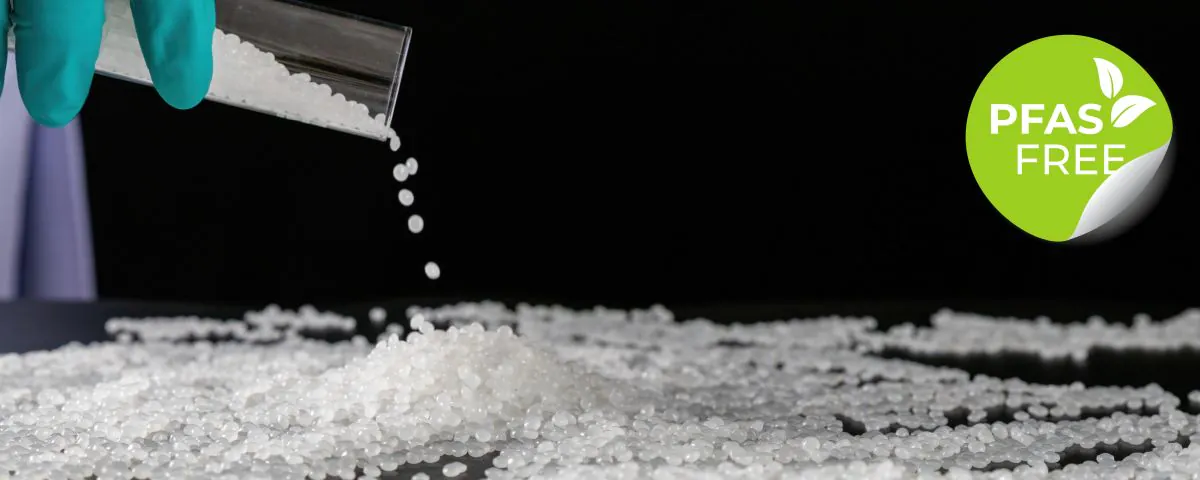Patent Booster Workshop – 3 days
Inventions! Technological breakthroughs in just a few days. Your experts can do it. We take care!

In recent years, the discussion about environmentally harmful chemicals has become increasingly important. One of these groups of chemicals is per- and polyfluorinated alkyl substances (PFAS). They are in focus of environmentalists and governments worldwide. A far-reaching ban on PFAS is currently being discussed. This could potentially have a massive impact on companies that make products containing these chemicals. The planned PFAS ban is a threat to many companies as it could severely limit their current business base. In addition to efforts to avert the PFAS ban, numerous organizations are already actively looking for solutions for their industrial business of the future. Because pressure to act also enables innovation.

PFAS are a group of chemicals known for their water and dirt repellent properties. They are used in a variety of products including textiles, packaging, personal care products and even firefighting foam. Despite their widespread use, PFAS are known for their environmental impacts and potential health risks. Studies have shown that they can accumulate in the environment and in the human body. With potentially serious consequences for ecosystems and human health.
To address these concerns, many governments around the world are planning a comprehensive ban on PFAS. This step is seen as a crucial step towards sustainability and environmental protection. Companies that have previously relied on PFAS-based products are faced with the challenge of finding alternative ways to produce their products without harming the environment. Companies that produce PFAS-based components for their customers have two alternatives. Either they find alternative ways to replace existing PFAS components themselves, or they abandon the sinking ship and set out to develop new business areas. If there is sufficient capacity or a high degree of decision uncertainty, both paths can initially be pursued in parallel.
Innovation plays a crucial role in overcoming challenges. Companies could invest more in research and development of PFAS-free alternatives. This could include the discovery of new materials and technologies that have the same or even improved properties as PFAS, but at the same time are more environmentally friendly. What is noteworthy here is that it is not always necessary to completely replace the existing PFAS material. PFAS plastics are often used as a multi-purpose solution, even though this may not be necessary. Similar to the use of cortisone in medicine. Maybe it wouldn’t be necessary, but it’s guaranteed to help in some way and you’ll quickly have a solution that you don’t have to think about too much. Even if the solution is often a little more expensive and less specific than perhaps needed.
In addition to closed innovation approaches in which companies deal with technology innovation and material development behind closed doors, open innovation approaches are also conceivable. Innovation collaborations between companies, governments and research institutions can accelerate progress and produce sustainable solutions. Important: You should consider how much time you want to give yourself until solutions are on the market. Complex collaborations often require a disproportionate amount of time until real solutions emerge. There are faster ways.
Inventions! Technological breakthroughs in just a few days. Your experts can do it. We take care!
Another promising approach is to switch to biodegradable materials. Companies could adapt their production processes to use materials that are subject to natural biodegradation processes. This would help reduce the impact on the environment while creating more sustainable products. Developing biodegradable alternatives may require investment in research and infrastructure, but the long-term environmental benefits could be significant. Actually not a separate approach, because it’s about replacing the PFAS solutions. Nevertheless, this strategic decision can also be seen as a separate path by also focusing on “organic” in external communication. The trend still continues. Even if it is not always completely clear in detail how much “organic” is actually more sustainable than conventional.

The idea of the circular economy is becoming increasingly important in sustainable business management. Companies could redesign their production processes to create a closed loop where products can be recycled and reused at the end of their life cycle. This requires not only innovative recycling technologies, but also a rethinking of product design to use easily recyclable materials. By implementing circular economy concepts, companies could not only produce more environmentally friendly products, but also reduce costs through more efficient use of resources. Also not a completely additional approach, but an additional perspective. And now that you’re thinking about fundamental changes, perhaps this can be taken into account straight away.
Sustainability is increasingly becoming a crucial factor in consumer decisions. And even if the consumer is often not the first person thought of in B2B, every B2B is ultimately a B2B2C with the consumer ultimately paying the bill. Companies that respond proactively to the planned PFAS ban could use this as an opportunity to transparently communicate their sustainability efforts. Clear and honest communication about how the company is responding to the new regulations and what sustainable practices it is implementing can increase consumer trust. Branding based on sustainability and innovation could help create positive public perception.
A creative approach to responding to the proposed PFAS ban could be to consider moving into other industries. Companies that have previously relied heavily on PFAS could redirect their resources and capabilities to industries where PFAS do not play a central role. This strategic pivot may require in-depth market analysis and business model adjustment, but offers the opportunity to enter new markets while offering more sustainable products. Such diversification could not only mitigate the impact of the PFAS ban, but also contribute to long-term business stability and resilience.
New business does not start on a piece of paper. It starts in the target audience. Learn how. 20 minutes live webinar. (in german only)
Companies that have extensive experience and expertise in producing PFAS-containing products could use these skills to develop innovative, PFAS-free alternatives. By adapting existing technologies and production processes, companies could produce products that not only meet the requirements of the proposed ban, but also meet consumers’ evolving needs for environmentally friendly solutions. Leveraging existing skills not only offers a smoother transition, but also the opportunity to position yourself as a pioneer in the development of sustainable alternatives.

A strategic consideration for companies could be to position themselves as niche players in markets where the PFAS ban is not imminent. An approach that may not last. Still a way to capture the business that fewer and fewer companies want to do. The first well-known companies are already withdrawing from PFAS, creating a vacuum that will sooner or later be filled by others. This requires a close analysis of global regulations and identification of regions or industries where PFAS are still permitted. By focusing on such niche markets, companies could continue to offer products containing PFAS while implementing sustainable practices and strengthening their market position. However, it is important to note that this approach involves some risk as regulations may change in different regions and the transition to more sustainable alternatives is likely inevitable in the long term.
The planned PFAS ban not only requires companies to be adaptable, but also to find creative and sustainable solutions. The different approaches discussed emphasize the diversity of strategies that companies can pursue. These not only provide opportunities to adapt to new regulations, but also open up opportunities for growth, innovation and the creation of a more sustainable future. Companies that act flexibly and proactively implement sustainable practices can not only overcome the challenges of the PFAS ban, but also have a long-term positive impact on the environment, society and the economy.
As a specialist for innovation in technology companies, TOM SPIKE is currently supporting several customers in repositioning themselves in view of the upcoming PFAS ban. These include projects with different orientations:
The right approach is primarily a decision based on business ambitions and aspirations. Let’s talk to find the right approach for your company!
What has proven successful? What not? Which approach suits the company? Free initial consultation.
The challenge: changing markets, supply chains and technologies How will your...
What ist TRIZ? A brief Introduction Many companies are faced with...
Management Consultants also help in engineering Innovation Consulting for technology innovation...
You are currently viewing a placeholder content from Google Maps. To access the actual content, click the button below. Please note that doing so will share data with third-party providers.
More Information